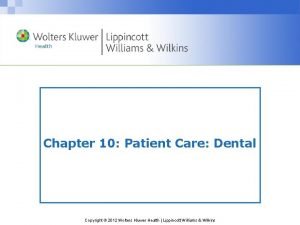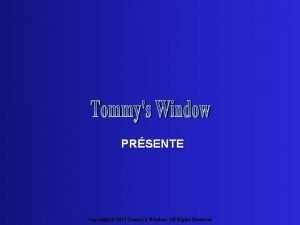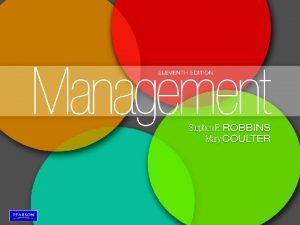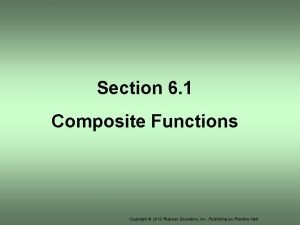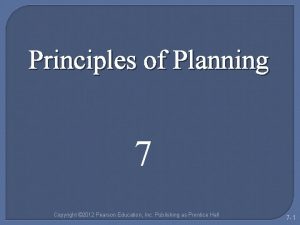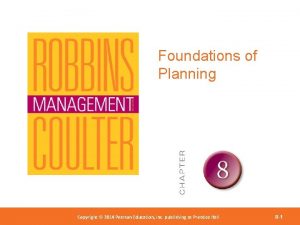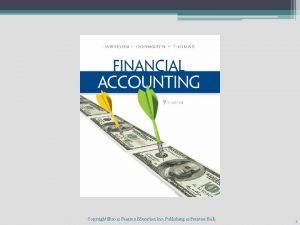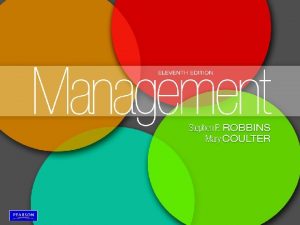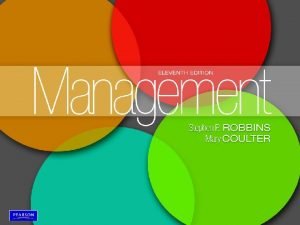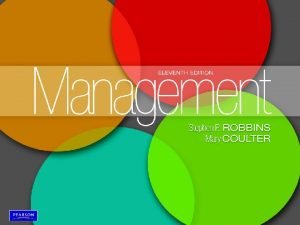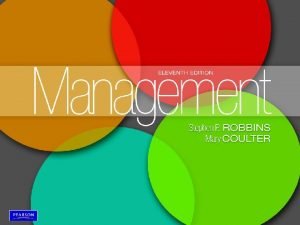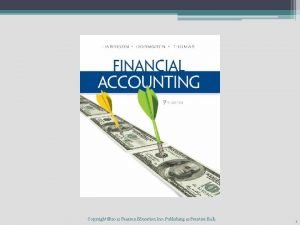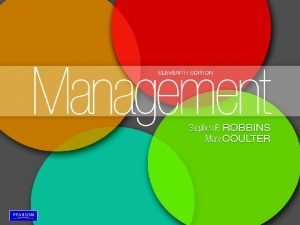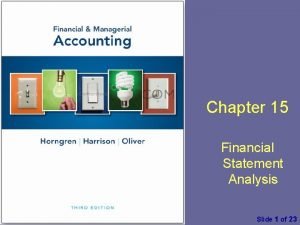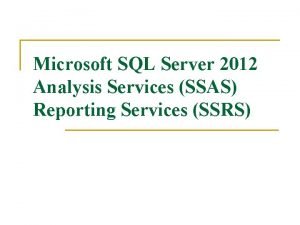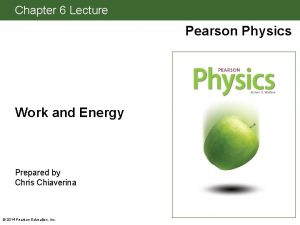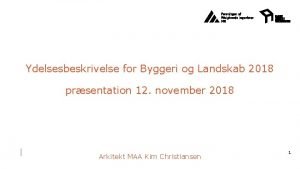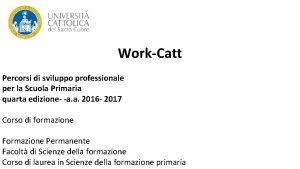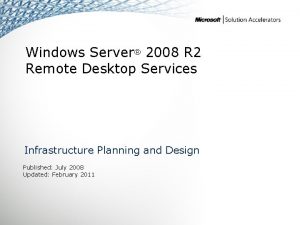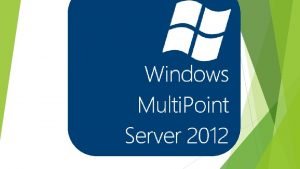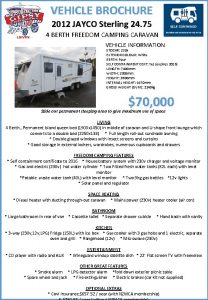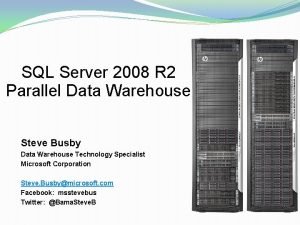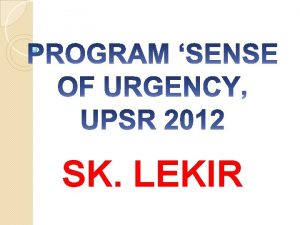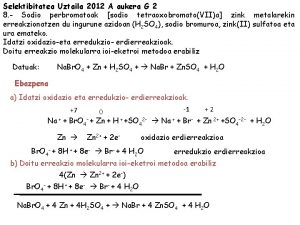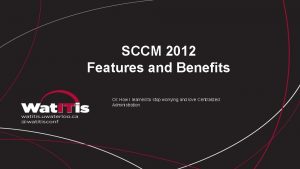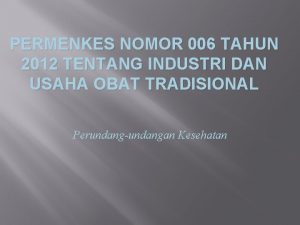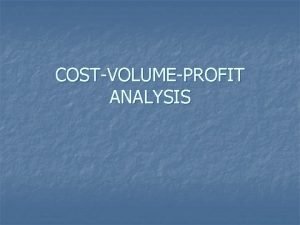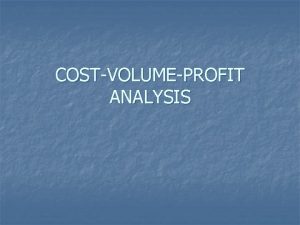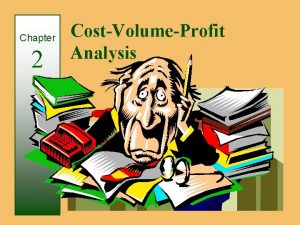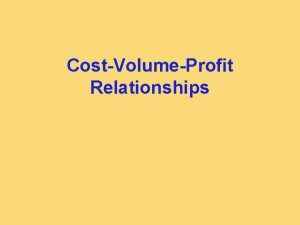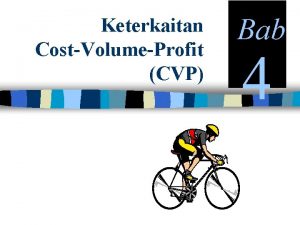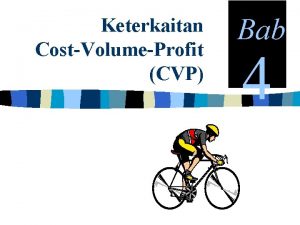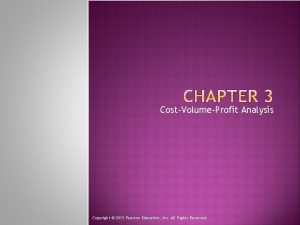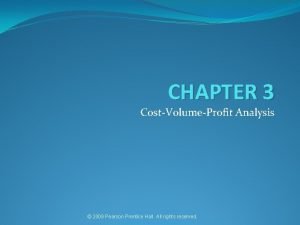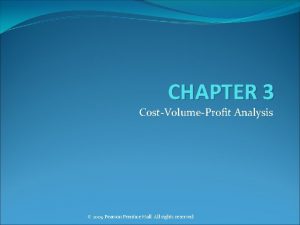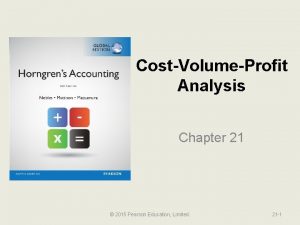CostVolumeProfit Analysis Chapter 19 1 Copyright 2012 Pearson








































































- Slides: 72

Cost-Volume-Profit Analysis Chapter 19 1 Copyright © 2012 Pearson Education, Inc. Publishing as Prentice Hall.

Learning Objectives Identify how changes in volume affect costs Use CVP analysis to compute breakeven points Use CVP analysis for profit planning, and graph the CVP relations Use CVP methods to perform sensitivity analyses 2 Copyright © 2012 Pearson Education, Inc. Publishing as Prentice Hall.

Learning Objectives Calculate the breakeven point for multiple products or services Distinguish between variable costing and absorption costing (see Appendix 19 A, located at myaccountinglab. com) 3 Copyright © 2012 Pearson Education, Inc. Publishing as Prentice Hall.

1 Identify how changes in volume affect costs 4 Copyright © 2012 Pearson Education, Inc. Publishing as Prentice Hall.

Types of Costs The effect of volume of activity on costs Variable costs Increase or decrease in total in direct proportion to changes in the volume of activity Fixed costs Do not change over wide ranges of volume Mixed costs Have both variable and fixed components 5 Copyright © 2012 Pearson Education, Inc. Publishing as Prentice Hall.

Variable Costs Total variable costs change in direct proportion to changes in the volume of activity If activity increases, so does the cost Unit variable cost remains constant Volume can be measured in many different ways: Number of units sold Number of units produced Number of miles driven by a delivery vehicle Number of phone calls placed 6 Copyright © 2012 Pearson Education, Inc. Publishing as Prentice Hall.

Total Variable Costs 7 Copyright © 2012 Pearson Education, Inc. Publishing as Prentice Hall.

Fixed Costs Tend to remain the same in amount, regardless of variations in level of activity Examples: Straight-line depreciation Salaries Part-time manager’s salary Total fixed costs do not change, but the fixed cost per event depends on the number of events The more activity, the less the fixed cost per unit 8 Copyright © 2012 Pearson Education, Inc. Publishing as Prentice Hall.

Total Fixed Costs and Fixed Costs per Unit 9 Copyright © 2012 Pearson Education, Inc. Publishing as Prentice Hall.

Mixed Costs Have both a fixed and variable component Example: Utilities that charge a set fee per month, plus a charge for usage 10 Copyright © 2012 Pearson Education, Inc. Publishing as Prentice Hall.

Mixed Costs 11 Copyright © 2012 Pearson Education, Inc. Publishing as Prentice Hall.

High-Low Method to separate mixed costs into variable and fixed components Identify the highest and lowest levels of activity over a period of time STEP 1: Calculate variable cost per unit Variable cost per unit = Change in total cost ÷ Change in activity volume STEP 2: Calculate total fixed cost Total fixed cost = Total mixed cost – Total variable cost STEP 3: Create and use equation to show the behavior of a mixed cost Total mixed cost = (Variable cost per unit X number of units) + Total fixed costs 12 Copyright © 2012 Pearson Education, Inc. Publishing as Prentice Hall.

High-Low Method: Steps 1 and 2 Data Step 1 Step 2 13 Copyright © 2012 Pearson Education, Inc. Publishing as Prentice Hall.

Step 3 ($2 x 400 event-playing hours) + $1, 000 = $1, 800 Now check your formula against the original data 14 Copyright © 2012 Pearson Education, Inc. Publishing as Prentice Hall.

Relevant Range of volume: Where total fixed costs remain constant and variable cost per unit remains constant Outside the relevant range, costs can differ 15 Copyright © 2012 Pearson Education, Inc. Publishing as Prentice Hall.

Philadelphia Acoustics builds innovative speakers for music and home theater systems. Consider the following costs. Identify the costs as variable (V), fixed (F), or mixed (M). 1. Units of production depreciation on routers used V to cut wood enclosures V 2. Wood for speaker enclosures F 3. Patents on crossover relays M 4. Total compensation to salesperson, who receives a salary plus a commission based on meeting sales goals V 16 5. Crossover relays Copyright © 2012 Pearson Education, Inc. Publishing as Prentice Hall.

Philadelphia Acoustics builds innovative speakers for music and home theater systems. Consider the following costs. Identify the costs as variable (V), fixed (F), or mixed (M). F 6. Straight-line depreciation on manufacturing plant V 7. Grill cloth M 8. Cell phone costs of salesperson (plan includes 1, 200 minutes; overseas calls are charged at an average of $0. 15 per minute) V 9. Glue F 10. Quality inspector’s salary 17 Copyright © 2012 Pearson Education, Inc. Publishing as Prentice Hall.

Martin owns a machine shop. In reviewing his utility bill for the last 12 months, he found that his highest bill of $2, 800 occurred in August when his machines worked 1, 400 machine hours. His lowest utility bill of $2, 600 occurred in December when his machines worked 900 machine hours. 1. Calculate (a) the variable rate per machine hour and (b) Martin’s total fixed utility cost. Variable cost per unit = Change in total cost ÷ Change in activity volume a. Variable cost per unit = ($2, 800 - $2, 600) ÷ (1, 400 – 900) Variable cost per unit = $200 ÷ 500 + 0. 40 per machine hour b. Total fixed cost = Total mixed cost – Total variable cost Total fixed cost = $2, 800 – (0. 40 X 1, 400) Total fixed cost = $2, 800 - $560 Total fixed cost = $2, 240 18 Copyright © 2012 Pearson Education, Inc. Publishing as Prentice Hall.

Martin owns a machine shop. In reviewing his utility bill for the last 12 months, he found that his highest bill of $2, 800 occurred in August when his machines worked 1, 400 machine hours. His lowest utility bill of $2, 600 occurred in December when his machines worked 900 machine hours. 2. Show the equation for determining the total utility cost for Martin’s. $ 0. 40 per machine hour + $2, 240 19 Copyright © 2012 Pearson Education, Inc. Publishing as Prentice Hall.

Martin owns a machine shop. In reviewing his utility bill for the last 12 months, he found that his highest bill of $2, 800 occurred in August when his machines worked 1, 400 machine hours. His lowest utility bill of $2, 600 occurred in December when his machines worked 900 machine hours. 3. If Martin’s anticipates using 1, 200 machine hours in January, predict his total utility bill using the equation from Requirement 2. ($ 0. 40 per machine hour x 1. 200 machine hours) + $2, 240 $480 +$2, 240 = $2, 720 20 Copyright © 2012 Pearson Education, Inc. Publishing as Prentice Hall.

S 19 -3: MIXED COSTS —HIGH -LOW METHOD Martin owns a machine shop. In reviewing his utility bill for the last 12 months, he found that his highest bill of $2, 800 occurred in August when his machines worked 1, 400 machine hours. His lowest utility bill of $2, 600 occurred in December when his machines worked 900 machine hours. 4. Draw a graph illustrating your total cost under this plan. Label the axes, and show your costs at 900, 1, 200, and 1, 400 machine hours. 21 Copyright © 2012 Pearson Education, Inc. Publishing as Prentice Hall.

2 Use CVP analysis to compute breakeven points 22 Copyright © 2012 Pearson Education, Inc. Publishing as Prentice Hall.

Basic CVP Analysis Expresses the relationships among costs, volume, and profit or loss Answers: How many products or services must the company sell to break even? What will profits be if sales double? How will changes in selling price, variable costs, or fixed costs affect profits? Assumptions: Managers can classify each cost as either variable or fixed Only factor that affects total costs is change in volume, which increases variable and mixed costs Fixed costs do not change 23 Copyright © 2012 Pearson Education, Inc. Publishing as Prentice Hall.

Breakeven Point Sales level at which operating income is zero: Total revenues equal total costs (expenses) Sales above breakeven result in a profit Sales below breakeven result in a loss Two methods to compute breakeven point: Income statement approach Sales revenue − Total costs = Operating income Contribution margin approach Sales revenue – Variable costs = Contribution margin – Fixed costs = Operating income 24 Copyright © 2012 Pearson Education, Inc. Publishing as Prentice Hall.

Income Statement Approach Express income in equation form and then break it down into its components: 25 Copyright © 2012 Pearson Education, Inc. Publishing as Prentice Hall.

Contribution Margin Approach Shortcut method The contribution margin is sales revenue minus variable costs (expenses) Called contribution margin because the excess of sales revenue over variable costs contributes to covering fixed costs 26 Copyright © 2012 Pearson Education, Inc. Publishing as Prentice Hall.

Contribution Margin Approach Rearrange the income statement—use the contribution margin to develop a shortcut method Shortcut equation: 27 Copyright © 2012 Pearson Education, Inc. Publishing as Prentice Hall.

Contribution Margin Approach Given fixed costs total $12, 000. The contribution margin per event is $120 ($200 sale price – $80 variable cost) Check your answer 28 Copyright © 2012 Pearson Education, Inc. Publishing as Prentice Hall.

Contribution Margin Ratio of contribution margin to sales revenue Used to compute the breakeven point in terms of sales dollars Contribution margin is equal to: Sales price – variable cost Contribution margin divided by sales revenue yields a percentage Percentage of each dollar of sales revenue that contributes toward fixed costs and profit 29 Copyright © 2012 Pearson Education, Inc. Publishing as Prentice Hall.

Contribution Margin Ratio Formula: Example: Yields the same breakeven as the contribution margin approach earlier 30 Copyright © 2012 Pearson Education, Inc. Publishing as Prentice Hall.

Story Park competes with Splash World by providing a variety of rides. Story sells tickets at $50 person as a one-day entrance fee. Variable costs are $10 person, and fixed costs are $240, 000 per month. 1. Compute the number of tickets Story must sell to break even. Perform a numerical proof to show that your answer is correct. Units sold = ($240, 000 + 0) ÷ ($50 - $10) Units sold = $240, 000 ÷ $40 = 6, 000 units to breakeven 31 Copyright © 2012 Pearson Education, Inc. Publishing as Prentice Hall.

S 19 -4: COMPUTING BREAKEVEN POINT IN SALES UNITS Story Park competes with Splash World by providing a variety of rides. Story sells tickets at $50 person as a one-day entrance fee. Variable costs are $10 person, and fixed costs are $240, 000 per month. 1. Compute the number of tickets Story must sell to break even. Perform a numerical proof to show that your answer is correct. Total sales revenue $300, 000 -Variable cost 60, 000 Contribution margin $240, 000 - Fixed cost 240, 000 Operating income $ 0 32 Copyright © 2012 Pearson Education, Inc. Publishing as Prentice Hall.

Story Park competes with Splash World by providing a variety of rides. Story sells tickets at $50 person as a one-day entrance fee. Variable costs are $10 person, and fixed costs are $240, 000 per month. 1. Compute Story Park’s contribution margin ratio. Carry your computation to two decimal places. $50 - $10 = $40 ÷ $50 = 0. 80 or 80% 33 Copyright © 2012 Pearson Education, Inc. Publishing as Prentice Hall.

Story Park competes with Splash World by providing a variety of rides. Story sells tickets at $50 person as a one-day entrance fee. Variable costs are $10 person, and fixed costs are $240, 000 per month. 2. Use the contribution margin ratio CVP formula to determine the sales revenue Story Park needs to break even. $240, 000 ÷ 0. 80 = $300, 000 34 Copyright © 2012 Pearson Education, Inc. Publishing as Prentice Hall.

3 Use CVP analysis for profit planning, and graph the CVP relations 35 Copyright © 2012 Pearson Education, Inc. Publishing as Prentice Hall.

Using CVP to Plan Profits Managers more interested in: Sales level needed to earn a target profit Profits they can expect to earn How many products or service events must be sold to earn a specific operating profit Use either method Set operating profit equal to desired profit 36 Copyright © 2012 Pearson Education, Inc. Publishing as Prentice Hall.

Graphing Cost-Volume-Profit Relations Graph provides a picture that shows how changes in the levels of sales will affect profits Four steps: 1. Choose a sales volume and plot the point for total sales revenue at that volume 2. Draw the fixed cost line 3. Draw the total cost line (total costs are the sum of variable costs plus fixed costs) 4. Identify the breakeven point and the areas of operating income and loss 37 Copyright © 2012 Pearson Education, Inc. Publishing as Prentice Hall.

Preparing a CVP Chart 38 Copyright © 2012 Pearson Education, Inc. Publishing as Prentice Hall.

Consider the following facts: A B C Number of units 1, 300 3, 600 7. 500 Sale price per unit $100 $40 $125 40 10 100 72, 000 60, 000 40, 000 180, 000 75, 000 100, 000 Variable costs per unit Total fixed costs Target operating income Calculate: Contribution margin per unit Contribution margin ratio Breakeven points in units Breakeven point in sales dollars Units to achieve target operating income 39 Copyright © 2012 Pearson Education, Inc. Publishing as Prentice Hall.

Consider the following facts: A B C Number of units 1, 300 3, 600 7. , 00 Sale price per unit $100 $40 $125 40 10 100 72, 000 60, 000 40, 000 180, 000 75, 000 100, 000 $60 $30 $25 Contribution margin ratio 60% 75% 20% Breakeven points in units 1, 200 2, 000 1, 600 $120, 000 $80, 000 $200, 000 4, 200 4, 500 5, 600 Variable costs per unit Total fixed costs Target operating income Calculate: Contribution margin per unit Breakeven point in sales dollars Units to achieve target operating income 40 Copyright © 2012 Pearson Education, Inc. Publishing as Prentice Hall.

John Kyler is considering starting a Web-based educational business, e-Prep MBA. He plans to offer a short-course review of accounting for students entering MBA programs. The materials would be available on a password-protected Web site; students would complete the course through self-study. Kyler would have to grade the course assignments, but most of the work is in developing the course materials, setting up the site, and marketing. Unfortunately, Kyler’s hard drive crashed before he finished his financial analysis. However, he did recover the following partial CVP chart: 1. Label each axis, the sales revenue line, the total costs line, the fixed costs, the operating income area, and the breakeven point. 2. If Kyler attracts 300 students to take the course, will the venture be profitable? 3. What are the breakeven sales in students and dollars? 41 Copyright © 2012 Pearson Education, Inc. Publishing as Prentice Hall.

1. Label each axis, the sales revenue line, the total costs line, the fixed costs, the operating income area, and the breakeven point. Breakeven g n i t a r e Op ome inc Total Cost Fixed Cost e u n e v e R s le a S 2. If Kyler attracts 300 students to take the course, will the venture be profitable? Will not be profitable. Possible loss of $8, 000 3. What are the breakeven sales in students and dollars? Breakeven at 400 students, $40, 000 in sales 42 Copyright © 2012 Pearson Education, Inc. Publishing as Prentice Hall.

4 Use CVP methods to perform sensitivity analysis 43 Copyright © 2012 Pearson Education, Inc. Publishing as Prentice Hall.

Sensitivity Analysis Predict how changes in sale prices, cost, or volume affect profits “What-if? ” analysis Allows managers to see how various business strategies affect profits Changing selling price Changing variable Costs Changing fixed Costs 44 Copyright © 2012 Pearson Education, Inc. Publishing as Prentice Hall.

Sensitivity Analysis: Example How will the lower sale price affect the breakeven point? Lower price yields higher unit sales to breakeven Higher prices yields lower unit sales to breakeven 45 Copyright © 2012 Pearson Education, Inc. Publishing as Prentice Hall.

Sensitivity Analysis: Example How will increased costs affect the breakeven point? Higher cost yields higher unit sales to breakeven Lower cost yields lower unit sales to breakeven 46 Copyright © 2012 Pearson Education, Inc. Publishing as Prentice Hall.

Sensitivity Analysis: Example How will the increased fixed costs affect the breakeven point? Higher fixed costs yields higher unit sales to breakeven Lower fixed costs yields lower unit sales to breakeven 47 Copyright © 2012 Pearson Education, Inc. Publishing as Prentice Hall.

Sensitivity Analysis Summary Exhibit 19 -6 48 Copyright © 2012 Pearson Education, Inc. Publishing as Prentice Hall.

Margin of Safety Excess of expected sales over breakeven sales Cushion, drop in sales, a company can absorb without incurring a loss Margin of safety in units Margin of safety in dollars 49 Copyright © 2012 Pearson Education, Inc. Publishing as Prentice Hall.

Story Park competes with Splash World by providing a variety of rides. Story sells tickets at $50 person as a one-day entrance fee. Variable costs are $10 person, and fixed costs are $240, 000 per month. 1. Suppose Story Park cuts its ticket price from $50 to $40 to increase the number of tickets sold. Compute the new breakeven point in tickets and in sales dollars. Units sold = ($240, 000 + 0) ÷ ($40 - $10) Units sold = $240, 000 ÷ $30 = 8, 000 units to breakeven $320, 000 sales dollars to breakeven 50 Copyright © 2012 Pearson Education, Inc. Publishing as Prentice Hall.

Story Park competes with Splash World by providing a variety of rides. Story sells tickets at $50 person as a one-day entrance fee. Variable costs are $10 person, and fixed costs are $240, 000 per month. 2. Ignore the information in Requirement 1. Instead, assume that Story Park increases the variable cost from $10 to $20 per ticket. Compute the new breakeven point in tickets and in sales dollars. Units sold = ($240, 000 + 0) ÷ ($50 - $20) Units sold = $240, 000 ÷ $30 = 8, 000 units to breakeven = $400, 000 in sales dollars 51 Copyright © 2012 Pearson Education, Inc. Publishing as Prentice Hall.

Story Park competes with Splash World by providing a variety of rides. Story sells tickets at $50 person as a one-day entrance fee. Variable costs are $10 person, and fixed costs are $240, 000 per month. 1. If Story Park expects to sell 6, 200 tickets, compute the margin of safety in tickets and in sales dollars. Expected sales - Breakeven sales = Margin of safety in units 6, 200 – 6, 000 = 200 in units Margin of safety in units x Sales price = Margin of safety in dollars 200 units x $50 = $10, 000 52 Copyright © 2012 Pearson Education, Inc. Publishing as Prentice Hall.

5 Calculate the breakeven point for multiple product lines or services 53 Copyright © 2012 Pearson Education, Inc. Publishing as Prentice Hall.

Multiple Product Lines Selling prices and variable costs differ for each product Different contribution to profits Weighted-average contribution margin computed Sales mix provides weights to make up total product sales Weights equal 100% of total product sales 54 Copyright © 2012 Pearson Education, Inc. Publishing as Prentice Hall.

Steps for Computing Breakeven Point with Multiple Product Lines To compute breakeven sales in units for multiple products, complete the following three steps: STEP 1: Calculate the weighted-average contribution margin per unit STEP 2: Calculate the breakeven point in units for the “package” of products STEP 3: Calculate the breakeven point in units for each product and then multiply the “package” breakeven point in units by each product’s proportion of the sales mix 55 Copyright © 2012 Pearson Education, Inc. Publishing as Prentice Hall.

Step 1 Calculate the weighted-average contribution margin per unit: 56 Copyright © 2012 Pearson Education, Inc. Publishing as Prentice Hall.

Step 2 Calculate the breakeven point in units for the “package” of products: 57 Copyright © 2012 Pearson Education, Inc. Publishing as Prentice Hall.

Step 3 Calculate the breakeven point in units for each product. Multiply the “package” breakeven point in units by each product’s proportion of the sales mix: 58 Copyright © 2012 Pearson Education, Inc. Publishing as Prentice Hall.

Proof Prove this breakeven point by preparing a contribution margin income statement: 59 Copyright © 2012 Pearson Education, Inc. Publishing as Prentice Hall.

Wet Weekend Swim Park sells individual and family tickets, which include a meal, three beverages, and unlimited use of the swimming pools. Wet Weekend has the following ticket prices and variable costs for 2012: Sale price per ticket Variable cost per ticket Individual 30 15 Family 90 60 Wet Weekend expects to sell two individual tickets for every four family tickets. Wet Weekend’s total fixed costs are $75, 000. 1. Compute the weighted-average contribution margin per ticket. 2. Calculate the total number of tickets Wet Weekend must sell to break even. 3. Calculate the number of individual tickets and the number of family tickets the company must sell to break even. 60 Copyright © 2012 Pearson Education, Inc. Publishing as Prentice Hall.

Wet Weekend expects to sell two individual tickets for every four family tickets. Wet Weekend’s total fixed costs are $75, 000. 1. Compute the weighted-average contribution margin per ticket. Individual Family $ 30 $ 90 Variable cost per ticket 15 60 Contribution margin per unit 15 30 2 4 $30 $120 Sale price per ticket Sales mix in units Contribution margin Weighted-average contribution margin per unit 61 Total 6 150 $25 Copyright © 2012 Pearson Education, Inc. Publishing as Prentice Hall.

Individual Family $ 30 $ 90 Variable cost per ticket 15 60 Contribution margin per unit 15 30 2 4 $30 $120 Sale price per ticket Sales mix in units Contribution margin Weighted-average contribution margin per unit Total 6 150 $25 2. Calculate the total number of tickets Wet Weekend must sell to break even. $75, 000 ÷ $25 = 3, 000 total tickets 3. Calculate the number of individual tickets and the number of family tickets the company must sell to break even. 3, 000 total tickets x 2/6 = 1, 000 individual tickets 3, 000 total tickets x 4/6 = 2, 000 family tickets 62 Copyright © 2012 Pearson Education, Inc. Publishing as Prentice Hall.

6 Distinguish between variable costing and absorption costing (Appendix 19 A—online at myaccountinglab. com 63 Copyright © 2012 Pearson Education, Inc. Publishing as Prentice Hall.

Primary Difference Between Absorption Costing and Variable Costing Absorption costing: Considers fixed manufacturing costs as inventoriable product costs Variable costing: Considers fixed manufacturing costs as period costs (expenses) 64 Copyright © 2012 Pearson Education, Inc. Publishing as Prentice Hall.

Summary of Differences Between Absorption Costing and Variable Costing Type of Cost Absorption Costing Variable Costing Product Costs (capitalized as Inventory until expensed as Cost of goods sold) Direct materials Direct labor Variable manufacturing overhead Fixed manufacturing overhead Direct materials Direct labor Variable manufacturing overhead Period Costs (expensed in period incurred) Variable nonmanufacturing costs Fixed manufacturing overhead Variable nonmanufacturing costs Fixed nonmanufacturing costs Income Statement Format 65 Conventional income statement Contribution margin income statement Copyright © 2012 Pearson Education, Inc. Publishing as Prentice Hall.

Chapter 19 Summary Variable costs are those costs that increase or decrease in total as the volume of activity increases or decreases. Fixed costs are costs that do not change over wide ranges of volume. Costs that have both variable and fixed components are called mixed costs. The high-low method is an easy way to separate mixed costs into variable and fixed components by requiring you to identify the highest and lowest levels of activity over a period of time. The relevant range is the range of activity where total fixed cost stays the same and variable cost per unit stays the same. 66 Copyright © 2012 Pearson Education, Inc. Publishing as Prentice Hall.

Chapter 19 Summary The breakeven point is the sales level at which operating income is zero—total revenues equal total costs. The breakeven point can be found by using the income statement approach, using zero for operating income. The breakeven point can also be found by dividing total fixed cost by the contribution margin per unit (sales price per unit – variable cost per unit). Breakeven analysis can be used to calculate the sales volume needed to earn a certain amount of profit, called target profit. Target profit is the operating income that results when sales revenue minus variable costs and minus fixed costs equals management’s profit goal. 67 Copyright © 2012 Pearson Education, Inc. Publishing as Prentice Hall.

Chapter 19 Summary Graphing various activity levels and costs gives a visual representation of operating levels that generate net income and operating levels that result in net loss. Sensitivity analysis is a “what if” technique that asks what results are likely if selling price or costs change or if an underlying assumption changes. The income statement approach to breakeven is just adjusted for the new proposed values. The margin of safety is the “cushion” or drop in sales that the company can absorb before incurring a loss. 68 Copyright © 2012 Pearson Education, Inc. Publishing as Prentice Hall.

Chapter 19 Summary Most companies sell more than one product. Selling price and variable costs differ for each product, so each product makes a different contribution to profits. To calculate break even for each product, we compute the weighted-average contribution margin of all the company’s products. The combination of products that make up total sales, called the sales mix (or product mix), provides the weights that make up total product sales. 69 Copyright © 2012 Pearson Education, Inc. Publishing as Prentice Hall.

Summary of the Appendix Variable costing assigns only variable manufacturing costs to products. Fixed manufacturing costs are considered period costs and are expensed immediately because the company incurs these fixed costs whether or not it produces any products or services. In variable costing, fixed manufacturing costs are not treated as product costs. Management accountants often prefer variable costing because contribution margin is readily apparent on the variable costing income statement. 70 Copyright © 2012 Pearson Education, Inc. Publishing as Prentice Hall.

71 Copyright © 2012 Pearson Education, Inc. Publishing as Prentice Hall.

Copyright All rights reserved. No part of this publication may be reproduced, stored in a retrieval system, or transmitted, in any form or by any means, electronic, mechanical, photocopying, recording, or otherwise, without the prior written permission of the publisher. Printed in the United States of America. 72 Copyright © 2012 Pearson Education, Inc. Publishing as Prentice Hall.
 Dentist copyright 2012
Dentist copyright 2012 Copyright 2012
Copyright 2012 Copyright 2012
Copyright 2012 Copyright 2012
Copyright 2012 Pearson education 2012
Pearson education 2012 2012 pearson education inc
2012 pearson education inc 2012 pearson education inc
2012 pearson education inc 2012 pearson education inc
2012 pearson education inc Olecranal region
Olecranal region Pearson education inc. 2012
Pearson education inc. 2012 Pearson 2012
Pearson 2012 Pearson education inc. 2012
Pearson education inc. 2012 2012 pearson education inc anatomy and physiology
2012 pearson education inc anatomy and physiology 2012 pearson education inc
2012 pearson education inc 2012 pearson education inc
2012 pearson education inc Pearson education 2012
Pearson education 2012 2012 pearson education inc
2012 pearson education inc Pearson education 2012
Pearson education 2012 Pearson education inc. 2012
Pearson education inc. 2012 2012 pearson education inc
2012 pearson education inc 2012 pearson education inc
2012 pearson education inc Pearson education 2012
Pearson education 2012 Pearson education inc publishing as pearson prentice hall
Pearson education inc publishing as pearson prentice hall 2012 pearson education inc
2012 pearson education inc Pearson education limited 2017
Pearson education limited 2017 Copyright pearson education inc
Copyright pearson education inc 2010 pearson education inc
2010 pearson education inc 2009 pearson education inc
2009 pearson education inc 2018 pearson education inc
2018 pearson education inc 2014 pearson education inc
2014 pearson education inc Copyright 2010 pearson education inc
Copyright 2010 pearson education inc Copyright 2010 pearson education inc
Copyright 2010 pearson education inc Copyright by pearson education inc. answers
Copyright by pearson education inc. answers 2008 pearson education inc
2008 pearson education inc 2005 pearson prentice hall inc
2005 pearson prentice hall inc Copyright 2009 pearson education inc
Copyright 2009 pearson education inc Copyright pearson education inc
Copyright pearson education inc Copyright 2010 pearson education inc
Copyright 2010 pearson education inc Copyright 2010 pearson education inc
Copyright 2010 pearson education inc Copyright 2010 pearson education inc
Copyright 2010 pearson education inc 2010 pearson education inc
2010 pearson education inc Copyright 2010 pearson education inc
Copyright 2010 pearson education inc Copyright 2010 pearson education inc
Copyright 2010 pearson education inc Copyright 2010 pearson education inc
Copyright 2010 pearson education inc Copyright 2009 pearson education inc
Copyright 2009 pearson education inc Copyright 2009 pearson education inc
Copyright 2009 pearson education inc 2009 pearson education inc
2009 pearson education inc 2009 pearson education inc
2009 pearson education inc Copyright pearson education inc
Copyright pearson education inc Pearson education 2011
Pearson education 2011 Pearson education inc publishing as pearson prentice hall
Pearson education inc publishing as pearson prentice hall Bob whelan pearson
Bob whelan pearson Educational pearson pearson times
Educational pearson pearson times Pearson education inc publishing as pearson prentice hall
Pearson education inc publishing as pearson prentice hall Pearson education inc publishing as pearson prentice hall
Pearson education inc publishing as pearson prentice hall Return on common stockholders equity formula
Return on common stockholders equity formula Fiancial analysis chapter 15 pearson solutions
Fiancial analysis chapter 15 pearson solutions Sql server analysis services 2012
Sql server analysis services 2012 Chapter 12 stoichiometry answer key pearson
Chapter 12 stoichiometry answer key pearson Pearson chapter 6
Pearson chapter 6 Ydelsesbeskrivelse 2018
Ydelsesbeskrivelse 2018 Eas scuola primaria esempi
Eas scuola primaria esempi Remote desktop virtualization host role server 2012
Remote desktop virtualization host role server 2012 Multipoint dashboard
Multipoint dashboard 2012 jayco sterling
2012 jayco sterling Windows movie maker 2012 windows 7
Windows movie maker 2012 windows 7 Jorc code 2012
Jorc code 2012 Parallel data warehouse sql server 2012
Parallel data warehouse sql server 2012 Upsr 2012
Upsr 2012 Selektibitatea 2012
Selektibitatea 2012 Benefits of sccm
Benefits of sccm Abnormal psychology ucf
Abnormal psychology ucf Permenkes no 006 tahun 2012
Permenkes no 006 tahun 2012
